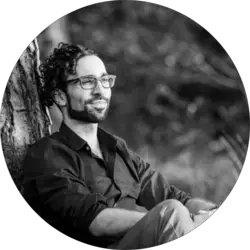![How To Deal With Sensory Overload [9 Tips For Overstimulation]](https://happyrubin.com/wp-content/uploads/2019/12/ik-ben-overprikkeld-150x150.jpg)
What is Neuro Linguistic Programming (NLP) and how does it work? [NLP Wiki]
![What is Neuro Linguistic Programming (NLP) and how does it work? [NLP Wiki]](https://happyrubin.com/wp-content/uploads/2015/09/wat-is-nlp-brein.png)
What is Neuro Linguistic Programming (NLP)? How does it work? This article serves as a ‘wiki’ to give an explanation about NLP and its meaning. NLP is a joyful, positive and loving way to improve your own life and the lives of the people around you. Read along to find out everything about NLP…
What is NLP? Let’s start with a short answer
Let’s give a brief meaning of NLP.
NLP = Doing what works.
NLP = All kinds of movements that work well, packed together.
NLP = Capture all those trends that work well in concrete step-by-step plans and models.
We were born with a brain, but nowhere are we given instructions for our brain. That is what NLP gives you! And not in a too serious way, but in an experimental, humorous and holistic way.
But let’s get a little more concrete. What exactly are NLP techniques? We can divide the NLP techniques into two groups :
- One half of NLP consists of visualization techniques , such as the Behavior Generator , Swish , Submodalities and / or Visual Squash. Think of it as extra specific and expanded versions of ‘standard visualization’ to work on your mindset.
- The other half of NLP consists of communication techniques , such as the Meta model , Milton model , Meta programs , Rapport and Sleight of Mouth.
Here you will find an overview of all NLP techniques.
NLP Exposed: Anyone who talks ‘fancy’ about NLP is fooling themselves and others
NLP is not ‘serious’ and ‘scientific’, but it is genuine, practice-oriented, experimental and holistic. NLP is thus a matter of doing, moving and taking action instead of psychologizing, endlessly talking and analyzing.
When someone gives a long talk and pretends NLP is very theoretical, using all kinds of expensive words, that person has not understood the core of NLP. Every NLP training or text should be packed with hands-on exercises, real-life examples and instructions. That is why you will find one or more exercises in almost all NLP articles on this website.
The posture in NLP training is one of pure practice: “Let’s experiment do follow them. Steps . Feel how it is different. Tell specifically what you saw and felt. Write what you differently next time is going to do.” More concrete than this is hardly possible.
And rightly so. According to the inventors, the complicated sounding word ‘Neuro Linguistic Programming’ (NLP) should not be taken too seriously because this title is meant as a joke. After all, it was invented by hippies in the 70s, as you’ll learn in the next section …
You can find all kinds of definitions about NLP in expensive terms such as “your brain is a ferrari”, “reprogramming yourself” and “neurological connections.”
What seems? Then you learn an NLP technique and in retrospect it was very simple: just imagine a picture. Or just give up my worrying thought in an Elmo voice.
Oh, so that’s it … Just call it visualization.
No, because otherwise you would have been done and there would be no reason to go into a lot of long training courses to finally understand that rocket science about ‘the power of your brain’.
NLP, what is that? Before we answer that … A bit about the origins of NLP

NLP is a joyful, positive and loving way to improve your own life and the lives of the people around you, but how did it come about?
NLP officially started in California in the 1970s and was developed by PhD researchers Richard Bandler and John Grinder.
Bandler was interested in why some therapists were more effective than others. To that end, he persuaded Grinder to focus together on three of the best therapists then active in finding clues about why they were so successful. They were Fritz Perls, Virginia Satir and Milton Erickson. He wrote down the conversations between these therapists and their clients. Grinder helped him analyze these conversations, drawing on his expertise in linguistics.
Together they discovered specific, recurring patterns . They did not look at exactly what the experts did, but mainly at the way in which . The result of this practical research was made available for everyone to learn as well. That is the birth of NLP as we know it today.
Fritz Perls, Virginia Satir and Milton Erickson performed their magic from a perspective of unconscious ability. The geniuses did not offer Bandler and Grinder a conscious model with a conscious description of their behavior. The modellers (Bandler and Grinder) absorbed and encoded the patterns unconsciously inherent in the geniuses.
What can you do with NLP?
NLP thus originated as the pursuit of coding how people organize their thoughts, feelings, language and behavior to achieve the results they are achieving. You can do a lot with this …
The first thing you can do with this is to ‘ model ‘ excellent expert performance so that you can then code it into concrete, conscious steps for others to learn too.
The second thing you can do with this is understand how people experience the world, and then change that so that people can have new options in their lives: coaching.
In addition, NLP has applications in, among other things:
- Education
- Training
- Sales
- Leadership
- Marketing
- Therapy
NLP is a soft skill. And what is a soft skill? Soft skills revolve around communicating, giving feedback, listening, body language, creativity, critical insight, solution-oriented thinking, stress resistance, emotional intelligence, dealing with conflict, coaching, attitude, visualization, and so on.
NLP revolves around all of those above and is arguably the ultimate soft skill toolset. Hard skills are, for example: accounting, sales, writing, software programming, and so on.
“Doctor Grinder and Mr. Bandler, you teach the students how to do things … Doctor Grinder, Mr. Bandler, you don’t understand the nature of a university. A university is not meant to teach people to do things. But to teach people about things. ”
– Charles Faulkner’s impersonation of the Dean of the University of Santa Cruz, California
What is NLP? Explained in a video
The institute that can explain the origins of NLP, and what it is, very nicely, is ‘NLPCA’:
6 different definitions of NLP
If you were to ask ten people what NLP is in one sentence, you would get ten completely different answers. And that is not surprising, because NLP is a collection of completely different schools and research results that work well. If you were to sum up NLP in a single sentence, there are six options that are best:
- A set of communication techniques, in other words: a collection of powerful influencing strategies.
- The study of the structure of subjective experience.
- The Study of Excellence: NLP is a research method to compare the performance of geniuses and mediocre achievers, and to make it explicit in a transferable and teachable way: mapping latent knowledge through an explicit model.
- How we organize our perceptions through the language of our mind to create our reality. In other words: a model for how we code, transfer and adjust our behavior. (This definition is explained in another article using the NLP communication model , which also teaches you what the words ‘neuro’, ‘linguistic’ and ‘programming’ stand for).
- NLP is an attitude. To be precise: an attitude of curiosity and willingness to experiment. To get a full picture of this attitude, you can look at the NLP presuppositions (principles) .
- NLP is: Going from an unwanted state of mind to a desired state of mind.
NLP is how we can use the language of our nervous system to consistently achieve our specific and desired goals (definition 4).
Wait a minute … what is the real NLP as it once originated?
If you take NLP as it originated in the 1970s and was further developed by Richard Bandler in the 1980s, there are only a handful of techniques:
- Advanced visualisations through submodalities , including the Swish technique and fast phobia . These submodalities techniques are used, for example, to replace an unwanted feeling from the past or present with a desired feeling; to make worrying thoughts sound different so that their charge no longer has a negative impact on you; or to make better decisions in the future.
- Connecting with people through the rapport technique.
- Anchoring a desired feeling so that you can always evoke it if you want to.
- Specifying language use: the meta model .
- Abstract language use: the milton model.
- Setting good goals.
NLP institutes and trainers who hold the Richard Bandler school teach you the above original techniques in their 7 or 8 day NLP Practitioner training. In their Master Practitioner training no techniques are added, but they are taught to improvise more with the given techniques.
Other NLP institutes and trainers go beyond those original frameworks and involve all kinds of new / related techniques in their NLP (Master) Practitioner training, such as Logical Levels, Sleight of Mouth, the COACH state, Time Line Therapy or Family Constellations. Here you will find a complete overview of what you may encounter at non-Bandler institutes.
The power of NLP
Many people spend several years and thousands of dollars in therapy to find out what is wrong with them and why they are having problems. They then have a four-centimeter thick file, but still cannot deal with the world afterwards. Very interesting, but what do you want?
As an NLP you want to give the client choices . Adding new options in our life. That means that we are not going to change anything. There are only new options to respond or to experience certain things. Someone who is shy can use a resource + anchor to be given the option to be assertive on all days she goes to work. She is no longer limited in what she does and how she does it.
One choice is for robots and with two choices you have a dilemma. So we go for at least three, because then you have a choice. You don’t need a lot of time to install these options. Half an hour. Problem gone. You only need to properly process an obstacle and then store it enough, for example in a box, lock on it and tucked away far away. You can still access it, you have that option, but it will take too much effort.
The strength of NLP also lies mainly in the fact that the words you use every day have a great effect on your health and happiness. An example of this is reframing (rethinking) problems. “It’s an opportunity!” Change your life by changing your attitude and your language!
Metaphor: seeing people as computers
You may have sometimes read the word “save” and “install” around NLP techniques. NLP therefore assumes that we can treat all that information in our nervous system the same as files on a computer. You can:
| Computer | Human |
| Put files on the hard drive. | Gaining knowledge and gathering information through our senses. |
| You can delete or overwrite files that you no longer want with an update. | Delete or replace negative habits and memories. This is a positive form of amnesia. |
| Issuing commands, for example in the command prompt or by starting a program. | People can also give commands to themselves and each other. They do this by setting goals, motivating each other, or by giving direct commands with hypnotic language. |
| Install programs. | You can also install new ‘software’ in yourself with NLP. This way you can learn new habits and skills. |
| Synchronization between different devices allowing information transfer to take place. | Synchronization between different people. You can learn this with NLP in very ingenious ways, including through your body language, word use and vocal tuning. |
| Intern processes. | People also have internal processes, and with NLP you learn to recognize the internal processes of other people. You do this, for example, by paying attention to their eye movements. They reveal what kind of internal strategy they use on the inside. |
What are the results of NLP?
With NLP you develop tools for excellence. You can use these tools to reprogram yourself and your clients. When applying NLP you achieve the following for yourself and other people:
- More understanding for yourself and others
- A growing awareness
- Control over your emotions
- Become more goal-oriented, set goals and achieve results
- All the qualities you want, for example self-assurance, control, assertiveness etc.
- Being able to deal with fears and many other complaints can be solved
- Being able to motivate yourself and others
- Bringing up desired moods at desired times
- Being able to resolve (inner) conflicts
- Changing habitual behaviors
- Make better choices
- Learning to relax

How can NLP be of further use?
The applications of NLP go far, but a number of practical examples are:
- For resolving fears and negative feelings.
- For overcoming phobias.
- Improve your skills in presenting to a large audience.
- Resolve conflicts.
- Changing habits that are harmful to your health.
- Developing management and leadership skills.
- Get rid of stress quickly.
- Listening effectively and showing empathy.
- Starting teams and motivating teams.
- Creating healthy relationships.
- Set goals and achieve them.
- Identifying other people’s natural learning styles.
Which techniques does NLP use?
The many techniques used in NLP include:
- Anchoring : Connecting an observable trigger to a state.
- Eye directions : noticing in which direction someone is looking and from that infer what that person thinks.
- Metamodel : a tool to notice and challenge limiting thoughts. You use questions to create more awareness.
- Follow and lead : Part of leading is patience. First you follow the other person in some way. This can be done, for example, by mirroring. Once trust is created in this way, you can begin to lead, allowing the other person to follow you.
This is the core of most NLP intervention techniques (standard 4-step template)
The most basic NLP technique is to evoke desired moods – by taking them out of other situations. It is amazing how you can solve a problem situation in a surprising way with a resource from a different context. This is the basis of every NLP technique. Every NLP intervention technique follows these four steps:
- Associate with the problem.
- Dissociate from the problem (for example, through a pattern interrupt or by asking the meta question, “What does he / she need?”)
- Associate in the resource (‘What would it be like to have {state of mind}?’)
- Link the resource to the problem: “And if you think about the problem with this feeling now, what happens now ?” “How do you feel about problem x while experiencing source y?”
Exercise: researching NLP and comparing it with other methodologies

I also received this exercise from my teacher Saskia:
Research what NLP means. Then compare it with at least three other communication theories, models, coaching methods or sales techniques. What is your definition of NLP (summary)? What is your definition of the other theory? Compare every theory with NLP: what are the similarities and the differences? Finally, give a conclusion that focuses on your personal goal: what do you want to achieve and how will NLP (and other methodologies) help you achieve your goal?
Variation: also do this assignment by comparing NLP with three other philosophies / views of life / movements / religions.
What is NLP? I know that now … Okay! What now? To practice!
Practice with the NLP models! That is the way you make flying hours and go from consciously incapable to unconsciously competent. Observe yourself for feedback (or observe yourself from the third observing position) and set a goal for the next time afterwards .
During your NLP Practitioner Training (this is the basic training), you are invited to practice all models at least twice as a ‘programmer’, or coach. During the second time , you let your observers focus only on your goal : their feedback is specifically focused on that the second time.
The role of the observer is also to keep the ‘programmer’ alert by means of an anchor. Anchoring is very useful if you are coaching someone. For example, a touch on the shoulder to keep the other focused, alert and awake.
In addition, it is recommended to write down how you reacted (what you said or did) in a particular exercise, and to write down afterwards what else you could have done to do the exercise even better.
Do you practice NLP in the wild? In coaching situations you always tell them first that you are going to do a coaching exercise with the other. With that framework you maintain the relationship.
Here you will find more tips about learning how to apply NLP.
The future of NLP
No one knows where it will go, but it seems that constant simplification is the keyword. Delete anything that takes you further away from ‘ experience ‘. Experience is sufficient and interventions can take place, without the need for language and left-brain understanding.
- Tony Robbins no longer uses techniques with cognitive steps in his seminars. He focuses on building a source of state of mind in the body.
- With New Code NLP, John Grinder has already removed a lot of superfluous language and left-brain elements from NLP. Moods automatically contain all of those things.
- NLP courses are getting shorter and shorter. Around the year 2000, the practitioner training was often still a 22+ day training in America. Now 8 days are already a lot.
Independent research will bring you the true meaning of NLP!
It is important that you do not adopt the models blindly, but that you check for yourself whether they are useful or not. You then make adjustments to the models yourself so that you can use them in the context you want. if you don’t find them useful in the way they are offered.
Now the question ‘What is NLP’ has been answered. NLP College encourages you to keep researching and discovering! Have an open mind for NLP as much as possible and absorb the mountains of information that can be obtained about it in this knowledge base . You can also follow a discounted NLP course at a renowned training institute.

![5 Best Self Care Tips For College Students [#1 Advice]](https://happyrubin.com/wp-content/uploads/2021/09/the-best-self-care-tips-for-college-students-440x264.jpg)
![How To Stick To New Year’s Resolutions: 9 Tips [Smart & Sure Ways]](https://happyrubin.com/wp-content/uploads/2019/12/tips-voor-goede-voornemens-440x264.jpg)
![How To Stop Being So Hard On Yourself [9 Great Tips]](https://happyrubin.com/wp-content/uploads/2019/12/we-moeten-zoveel-van-onszelf-en-anderen-150x150.jpg)

![19 Best Ice Breaker & Get-To-Know-Eachother Games [Fun & Simple]](https://happyrubin.com/wp-content/uploads/2018/02/leukste-ijsbrekers.jpeg)
![Becoming More Social: 41 Tips [Improving Social Skills] [List]](https://happyrubin.com/wp-content/uploads/2018/06/sociale-vaardigheden1.jpeg)
![How to start a conversation with anyone: 15 tips [Making contact]](https://happyrubin.com/wp-content/uploads/2017/08/gesprekstechnieken1.jpeg)
![372 Friend Tag Q&A Questions [Best Friend Quiz]](https://happyrubin.com/wp-content/uploads/2019/05/best-friend-tag-vragen-voorbeelden.jpg)



![Clingy & controlling behavior of partner/date [Extreme examples]](https://happyrubin.com/wp-content/uploads/2020/06/claimerig-gedrag-van-partner-eigenschappen-en-voorbeelden-150x150.jpg)

![How to recognize if a man is in love [Signals & his body language]](https://happyrubin.com/wp-content/uploads/2020/05/verliefd-gedrag-van-mannen-herkennen-150x150.jpg)


![Free will and religion / theology [Verses & Quotes on free will]](https://happyrubin.com/wp-content/uploads/2020/10/religion-on-free-will-quotes-1050x640-1-150x150.jpg)

![Dealing With Setbacks & Hardship [Lessons & Examples]](https://happyrubin.com/wp-content/uploads/2018/11/omgaan-met-tegenslag-tips-hoe-dan.jpeg)
![NLP Agreement Frame: Use these exact sentences [Examples]](https://happyrubin.com/wp-content/uploads/2020/10/agreement-frame-nlp-1125x640-1-440x264.jpeg)
![122 Best Comebacks In Any Situation [Best Examples]](https://happyrubin.com/wp-content/uploads/2020/06/beste-comebacks-technieken-tips-440x264.jpg)
![Using Hypnosis to Stop Smoking [HowTo]](https://happyrubin.com/wp-content/uploads/2020/05/stoppen-met-roken-door-hypnose-150x150.jpg)
![Presuppositions language pattern: meaning & examples [NLP]](https://happyrubin.com/wp-content/uploads/2020/04/wat-zijn-vooronderstellingen-150x150.jpg)
![Peripheral Vision: Meaning & Exercise [Essential Skill]](https://happyrubin.com/wp-content/uploads/2020/04/perifeer-zicht-trainen-tips-150x150.jpg)

![How To Start A Coaching Business [21 Smart Tips]](https://happyrubin.com/wp-content/uploads/2018/11/coachingpraktijk-starten-tips.jpeg)
![How to make dreams come true? [33 tips to realize dreams 100%]](https://happyrubin.com/wp-content/uploads/2018/05/dromen-mijlpalen.jpeg)
![How To Become Rich? 27 Millionaire Tips [Guaranteed To Work]](https://happyrubin.com/wp-content/uploads/2018/01/hoe-kan-ik-rijk-worden.jpeg)
![77 Best Online Marketing Tools [Recommendations] [Also Free]](https://happyrubin.com/wp-content/uploads/2018/08/beste-onlne-marketing-tools-tips.jpeg)
![Complete List Of Virtues & Qualities [Including Explanation]](https://happyrubin.com/wp-content/uploads/2018/12/kernkwaliteiten-uitleg.jpeg)
![Being Attentive: How Do You Do That? [Meaning & 9 Tips]](https://happyrubin.com/wp-content/uploads/2019/05/attent-zijn.jpg)
![Being Conscientious: Meaning Of This Virtue [Explained]](https://happyrubin.com/wp-content/uploads/2018/07/Consciëntieus-persoon.jpg)


![Best Books About Burn-Out [Top 10] [Update 2025]](https://happyrubin.com/wp-content/uploads/2020/06/beste-boeken-over-burnout-lijst-440x264.jpg)
![Best Self-love Books [Top 10] [Update 2025]](https://happyrubin.com/wp-content/uploads/2020/04/beste-boeken-over-zelfliefde-aanraders-440x264.jpg)
![Life changing books: 10 books that change your life [2025 Update]](https://happyrubin.com/wp-content/uploads/2020/03/levensveranderende-boeken-tips-150x150.jpg)
![Top 10 Best Books: Recommendations Per Genre [2025 Update]](https://happyrubin.com/wp-content/uploads/2019/12/best-books-per-genre-150x150.png)
![Best Books On procrastination: Must Reads [List] [2025 Update]](https://happyrubin.com/wp-content/uploads/2019/11/beste-boeken-over-uitstelgedrag-tips-150x150.jpg)
![Joe Dispenza: Events To Attend [2025 & 2026] [All Info]](https://happyrubin.com/wp-content/uploads/2020/02/joe-dispenxa-events-440x264.png)
![Best Online Study Options [Online Education Top List]](https://happyrubin.com/wp-content/uploads/2019/03/best-home-study-options-440x264.png)
![Teachable Review & Experiences 2025 [Bad Online Training Tool?]](https://happyrubin.com/wp-content/uploads/2020/02/Teachable-review-ervaringen-150x150.png)
![Audible Review, Experiences & Special Discount [Scam?]](https://happyrubin.com/wp-content/uploads/2020/01/audible-review-ervaringen-150x150.png)
![Guest Posts Wanted [Free & Always Directly Accepted]](https://happyrubin.com/wp-content/uploads/2019/05/gastbloggen-regels.jpg)

Awesome, your article is wonderful, I got a lot of information, and wrote this article very well. Thank you for sharing such information. Chech this https://www.ttgls.in/
I read your blog. It’s very informative, it gives a brief description about NLP. I recommend this blog and Anil Thomas NLP, if you want to know more about NLP.
Thank you for your informative blog about nlp and its defination i am being reading about it and thinking of taking services its very nice blog i am learning from you and ttgls for more visit https://www.ttgls.in
great article. i like nlp techniques.
It’s a wonderful blog, it tells us about various benefits of NLP training on business. I recommend this blog and Anil Thomas NLP, if you want to know more about NLP.